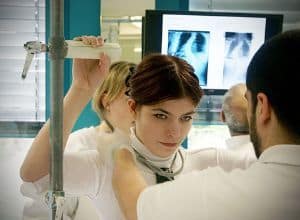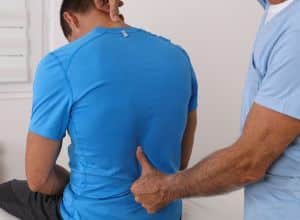Scoliosis is a complex disease that even the best scoliosis chiropractor still does not know what causes 80% of scoliosis cases, and there is no cure. But there is still hope! There are proven methods to treat scoliosis and reduce the severity of its symptoms.
X-rays allow a scoliosis chiropractor to measure each person’s spine’s unique, three-dimensional curve to determine the best treatment method.
What Causes Scoliosis?
There are different types of scoliosis, but its most common form is adolescent idiopathic scoliosis. In some patients, scoliosis curves could be traced to structural abnormalities, like incorrectly formed vertebrae or disc derangements.

However, other times, these curves could be linked to imbalances in spinal musculature, leg-length differences, or nervous system disorders if the lateral curve occurs in your mid-spine, the rib position shifts concerning their connections with this spinal area.
Aside from the curve, a scoliosis chiropractor would usually look for abnormal protrusion of the ribs and perform a test to see a patient’s capacity to do a range of motions. During this exam, an individual bends forward to touch their toes, and the scoliosis chiropractor checks on the ribs on the sides of the spine.
If a side of the ribs sits higher, the chiropractor will suspect scoliosis. This same test may determine this condition’s specific causes and the curvature’s severity. However, because not all scoliosis chiropractors could diagnose scoliosis, it is crucial to find a professional chiropractor who will be there throughout the diagnosis and assessment.
Can Scoliosis Be Reversed?
For mild cases, the patient is commonly monitored for progression. Mild curvature does not cause back pain more than the normal spine. However, treatment is highly recommended if the curve shows rapid progression or increases beyond 30 degrees. With proper monitoring, diagnosis, and treatment, scoliosis should not impede anyone from having a healthy, normal lifestyle. Nevertheless, if you suspect scoliosis, the first step is to visit your scoliosis chiropractor immediately.

Know that chiropractic care and adjustments can significantly reduce the scoliosis curve angle. Visiting a chiropractor specializing in diagnosing and treating scoliosis will help prevent the onset of severe spinal deformities.
Chiropractic treatment for scoliosis involves routine adjustments with the hands or a device. The goal is to realign the bones, muscles, and joints.
Diagnosing Scoliosis
Most chiropractors aren’t trained or equipped to effectively diagnose scoliosis-related issues. As a result, it’s easy to miss the underlying root causes and related issues such as instability of the surrounding ligaments.
Effective diagnosis is central to developing the right treatment plan for you and likely to deliver results. From there, you can move into treatment.
Traditional Chiropractic Treatment for Scoliosis
Traditional chiropractic treatment applies a general approach, the same as the scoliosis chiropractor would for any other patient experiencing back problems. Nevertheless, if the chiropractor is not practiced in scoliosis and is familiar with its intricacies, traditional chiropractic treatment is unlikely to affect the Cobb angle much.
This method is only recommended for patients over 13 with very small Cobb angles of 20 degrees or less. Traditional treatment can be useful for relieving pain but not for physically straightening the Cobb angle in scoliosis patients.

To mobilize the spine and straighten the curve, traditional chiropractors might press down on the spine and rib cage while the patient lies on their stomach (this is often referred to as “adjusting on the high side of the rainbow.”).
However, the irregular curve of the spine sometimes develops to take the tension out of the nerves. Pushing down on the spine does not relieve this tension; it further aggravates the nerves. With scoliosis, the spine is not stuck, as it is with most other chiropractic issues, but rather it curves in the wrong direction. You cannot mobilize a scoliotic spine without also stabilizing and correcting it.
Scoliosis-Specific Chiropractic Procedure for Scoliosis
Scoliosis-specific chiropractic procedure for scoliosis goes outside of the traditional guidelines to stabilize the curve. Aiming to correct the spine into a classic spinal curve gradually, scoliosis-specific adjustments are precise and gentle. This method could help people in all walks of life — people who’ve already had surgery and do not want to have it again, people trying to avoid surgery, teenagers who do not want to wear a brace, and most other situations.
Most individuals think of scoliosis as a sideways spine curve, but it’s a bit more complicated. A spine should have three curves:
- The cervical lordosis points forward in the neck.
- The thoracic kyphosis points backward in the middle of the back.
- The lumbar lordosis points forward in the low back.
- Scoliosis forces the spine differently for one or more of these natural curves
People with scoliosis are double-jointed in the neck. This hypermobility causes the joints to be unstable and puts them at a higher risk of injury and dislocation if not treated gently. There’s no twisting or turning of the neck in scoliosis-specific adjustments. Scoliosis-specific adjustments employ a precision mechanical instrument to adjust the neck and other body joints.
The first step to restoring the spine’s good curves is to recenter the head. While the patient is sitting up, and adjusting instrument delivers precise but gentle forces into the neck’s bones. These forces work to place your neck into the ideal position. Adjustments might also be performed on the back and hips based on the 3D measurements of the spine determined from x-rays.
Numerous chiropractors claim to specialize in scoliosis when their knowledge is limited. It is important to start a dialogue with your doctor to ensure you’re receiving care from a chiropractor who practiced in scoliosis. If your scoliosis chiropractor isn’t giving you the desired results or adjusting the treatment to yield them, it might be time to get a different doctor.
What Happens During a Chiropractic Adjustment?
A scoliosis chiropractor will often give an adjustment as part of chiropractic care. That could be done by hand or with machines to try and alleviate pain and help loosen up the back.
Nevertheless, when a patient has scoliosis, the treatment is different. A traditional chiropractic adjustment may apply pressure to the spine without adjusting for a person with scoliosis curvature.

That’s why it’s important to ensure your scoliosis chiropractor understands your condition and can help adjust your spine to minimize the curvature.
Regarding scoliosis, the spine isn’t in a stuck position; it just occurs to curve in the wrong direction. As long as the scoliosis chiropractor is aware, he could adapt a spinal adjustment for the curve. That can help alleviate some of the curvatures of the spine and help reduce pain. There are other benefits to chiropractic care too.
What Are the Benefits of Chiropractic Care?
While chiropractic care could help anyone and everyone from spinal misalignments, there are more benefits for scoliosis patients. Below, we discuss the benefits of routine chiropractic care as part of the scoliosis treatment plan.
#1. Ease Symptoms
Regular chiropractic care could help ease scoliosis symptoms by relieving muscle stress and nerve pressure due to misalignments in the spine.
Common symptoms of scoliosis include:
- Chronic neck and back pain
- Muscle spasms in the spine
- Limited range of motion, specifically in the upper body
Through chiropractic care, muscles can better relax and improve their range of motion.
For example, a chiropractic adjustment of the spine to realign it with its natural curvature will release pressure on nerve roots and give more space for muscles to relax. This relief allows a patient suffering from scoliosis to breathe easier and move around without as much restriction.
#2. Relieving Discomfort
Regular spinal adjustments from a qualified scoliosis chiropractor may also help with scoliotic pain by relieving pressure on the nerves causing discomfort. While pain is a common symptom of scoliosis, anyone with back pain can attest to the benefit of discomfort relief.
Therefore, for scoliosis patients especially, regular chiropractic adjustments can help reduce pain and discomfort.
#3. Slows Progression
Scoliosis is often diagnosed as a progressive condition where symptoms worsen over time. The scoliosis curve can worsen by as much as one degree per year without treatment, so patients are encouraged to seek chiropractic care regularly.
To combat curvature progression, regular chiropractic care can be a helpful treatment to slow scoliotic symptoms. As a result, scoliosis chiropractors often recommend that scoliosis patients receive spinal adjustments at least three times per week for the duration of their lives to slow progression and avoid scoliosis surgery.
What Should I Look for in Chiropractic Treatment Plans?
The most successful treatments for scoliosis and scoliotic pain address the underlying causes, not just the symptoms. Therefore, two key components are needed when exploring treatment through chiropractic care.
#1. Crafting a Customized Treatment Plan
No two scoliosis cases are identical – each patient could experience different trigger points, degrees of severity, and symptoms. Effective treatment plans rely entirely on the individual patient’s x-ray and initial exam. Therefore, you must partner with a scoliosis chiropractor that avoids the cookie-cutter approach.
After a thorough exam and x-ray, the scoliosis chiropractor will find out the precise area where added pressure is on your nerves. Then, upon assessing the degree of severity concerning your spinal alignment, a trusted scoliosis chiropractor will create a long-term scoliosis treatment plan designed to fix the root of the issue and treat your symptoms along the way.
#2. Exploring Your Expanded Treatment Options
Regular chiropractic care offers more benefits than alternatives like surgery or bracing because it can help correct scoliosis before you experience increased pain. However, you can supplement your chiropractic treatment with additional features.
Dependent upon a discussion with a qualified and licensed scoliosis chiropractor, your unique treatment plan could include customized exercise plans, laser therapy, traction therapy, and even acupuncture.
The Goal of Scoliosis Treatment
As a progressive condition with an unknown cure, the main goal of scoliosis treatment is to achieve a curvature reduction structurally, and any effective treatment plan has to include sustainability; work will need to be continued to maintain that curvature reduction.

It means that the scoliosis chiropractor you are seeking treatment from has the experience and knowledge to comprehensively administer and assess a scoliosis X-ray, which provides the information that becomes the roadmap for treatment.
A Final Word on Choosing the Right Scoliosis Chiropractor and Chiropractic Care for Scoliosis
When people have scoliosis, they are essentially double-jointed in the neck. The added mobility can put extra stress on the joints and open you up for an increased risk of injury or dislocation. Therefore, working with someone who understands scoliosis and where to align the spine correctly is essential. If you need a reliable scoliosis chiropractor to work on a treatment plan with you, please contact us today!
FAQ
Can a chiropractor help with scoliosis?
A lot of scoliosis patients find chiropractic treatments and adjustments can help reduce their pain by strengthening their body’s core and minimizing the pressure on their nervous system.
How does a chiropractor help scoliosis?
A scoliosis chiropractor can create a non-surgical and drug-free treatment plan that addresses multiple scoliosis symptoms.
